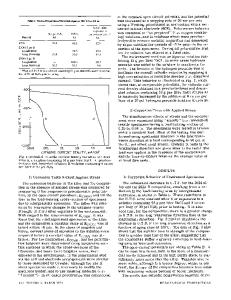Corrosion Protection of Aluminum-Matrix Composites
- PDF / 337,130 Bytes
- 6 Pages / 414.72 x 648 pts Page_size
- 76 Downloads / 367 Views
ABSTRACT Aluminum-matrix composites are attractive in their combination of low CTE and high thermal conductivity. Anodizing is an effective surface treatment for improving the corrosion resistance of aluminum-matrix composites. ForSiC filled aluminum, anodizing was performed successfully in an acid electrolyte, as usual. However, for AIN filled aluminum, anodizing needed to be performed in an alkaline (NaOH) electrolyte instead of an acid electrolyte, because NaOH reduced the reaction between AIN and water, whereas an acid enhanced this reaction. The concentration of NaOH in the electrolyte was critical; too high a concentration of NaOH caused the dissolution of the anodizing product (A120 3) by the NaOH, whereas too low a concentration of NaOH did not provide enough ions for the electrochemical process.
INTRODUCTION Metal matrix composites (MMCs) fabricated with lightweight aluminum alloy matrices and high modulus SiC or AIN particle reinforcements offer low coefficient of thermal expansion and excellent mechanical properties. SiC reinforced MMC is more commonly used than AIN reinforced MMC, but AIN reinforced MMC exhibits higher tensile strength and ductility at 300-400'C and at room temperature after heating at 600TC for 10-20 days. The latter also exhibits greater resistance to compressive deformation at 5250 C due to the lack of a reaction between A] and AIN, in contrast to the reaction between Al and SiC in SiC reinforced MMC [1]. Though both MMCs are promising for applications, corrosion can occur. Corrosion is usually prevented by chemical passivation coatings [2], polymer coatings [3] and/or anodized coatings [4]. The anodization of an aluminum alloy is an electrochemical method of converting aluminum into aluminum oxide (A120 3) by applying an external current in the presence of an electrolyte. The most widely used electrolyte for anodizing is acid, such as a sulfuric acid solution. There are two types of sulfuric acid anodizing: (1) conventional anodizing, which is performed at room temperature and provides a fairly hard oxide film about 10 pm thick; (2) hard anodizing, which is performed at 0°C and provides an oxide film about 50 ptm thick with extreme hardness. The oxide film consists of a thin continuous barrier layer below a thick, porous layer. The structure of the porous layer was characterized by Keller et al. [5] as a close packed array of columnar hexagonal cells such that each cell contains a central
129 Mat. Res. Soc. Symp. Proc. Vol. 390 01995 Materials Research Society
columnar pore normal to the substrate surface. The porous layer has to be sealed in order to improve the corrosion resistance after anodizing. It has been said that, by sealing, anodic coatings are partly converted to more voluminous boehmite (Al 2O 3'nH 2O) to plug the pores [6]. It has been shown that the conventional anodizing method is less effective for the corrosion protection of Al MMCs than for the aluminum alloy due to the presence of the reinforcement phase because the initiation and growth of the oxide film is i
Data Loading...











